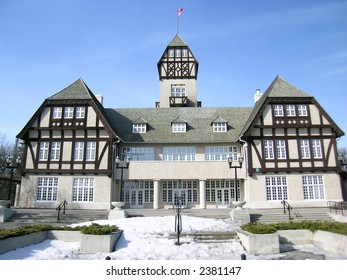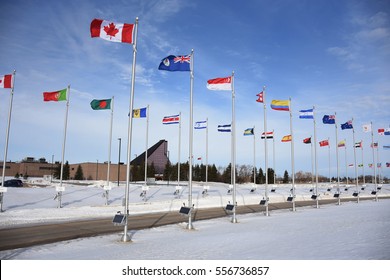About Manitoba
As Canada spread its expansive territories from the Atlantic to the Pacific, there’s a central heartland that often evokes a sense of wonder and curiosity for many. That heartland is Manitoba, the fifth most populous Canadian province, often referred to as the “Gateway to the West”.
Situated right at the longitudinal centre of Canada, Manitoba’s geographical prominence is beyond mere cartographical charm. With its pristine lakes, lush boreal forests, and the wide expanse of the prairies, Manitoba plays a significant role in the nation’s ecological and cultural tapestry.
A look at the population metrics provides an even more fascinating narrative. Boasting a population of approximately 1.4 million residents, a major fraction resides in the capital city, Winnipeg. This urban setting juxtaposed against the serene wilderness offers a dichotomy that’s hard to find elsewhere. Residents here proudly claim their Manitoba heritage, with indigenous communities and diverse immigrants weaving a rich societal fabric.
Manitoba’s strategic location has played a pivotal role in shaping Canada’s trade and transportation. Historically, it served as an essential crossroad for indigenous trade routes, fur trading, and later, the Canadian Pacific Railway. This legacy is evident in the bustling activity one witnesses in Winnipeg’s commercial districts and the Port of Churchill, the only Arctic deep-water port in Canada.
Moreover, the province is not just about bustling cities and tranquil landscapes. Manitoba has become a hub for cultural festivals, including the much-celebrated Winnipeg Folk Festival and the Festival du Voyageur. These events do not just serve as entertainment but are a testament to the province’s commitment to celebrate its history and diverse population.
In terms of economic contributions, agriculture, particularly wheat and canola farming, plays a substantial role. Yet, it’s not just about the golden fields of crops swaying under the northern sun. The province is also rich in minerals, making mining another key industry. Manitoba’s lakes are another treasure, providing bountiful catches of fish, particularly the delectable Manitoba Walleye.
Education and research are other spheres where Manitoba is leaving its mark. Institutions such as the University of Manitoba are pioneering research in various fields and nurturing the next generation of global leaders.
In conclusion, Manitoba isn’t just another province on the map of Canada. It’s a land that bridges the vibrant hues of urbanity with the serene tones of nature. With its ever-growing population, cultural vigour, and economic contributions, Manitoba stands as a testament to Canada’s diverse and thriving spirit.
Population Characteristics
According to the latest census, Manitoba has a population of around 1,342,153 people. The province's population is in increased . Between 2016 and 2021, the population of Newfoundland and Labrador has increased by 4.99%.
| Population in 2016 | Population in 2021 | Difference |
|---|---|---|
| 1,278,365 | 1,342,153 | +4.99% |
Population By Genders
The male population of Manitoba is around 666,490 while the female population is around 675,660.
Of the 1,342,153 total population in Manitoba, the largest gender is female with around 675,660 women within the population.
| Male | Female | Difference |
|---|---|---|
| 666,490 | 675,660 | +1.36% |
Population by Age Characteristics
Manitoba has a young population. The majority of the population is people aged 30 to 34 years old, accounting for 6.80% of the total population. The province median age is 38.40.
| Data | Male | Female | Difference | Total |
|---|---|---|---|---|
| 30 to 34 years | 45,805 6.90% | 46,000 6.80% | 0.42% | 91,805 6.80% |
| 20 to 24 years | 48,255 7.20% | 43,160 6.40% | 10.56% | 91,415 6.80% |
| 25 to 29 years | 46,240 6.90% | 44,230 6.50% | 4.35% | 90,470 6.70% |
| 35 to 39 years | 44,695 6.70% | 45,450 6.70% | 1.66% | 90,150 6.70% |
| 55 to 59 years | 43,040 6.50% | 44,255 6.50% | 2.75% | 87,295 6.50% |
| 5 to 9 years | 44,515 6.70% | 41,735 6.20% | 6.25% | 86,250 6.40% |
| 10 to 14 years | 44,190 6.60% | 42,060 6.20% | 4.82% | 86,250 6.40% |
| 60 to 64 years | 42,080 6.30% | 43,075 6.40% | 2.31% | 85,155 6.30% |
| 40 to 44 years | 41,690 6.30% | 42,840 6.30% | 2.68% | 84,530 6.30% |
| 15 to 19 years | 41,945 6.30% | 38,965 5.80% | 7.10% | 80,905 6.00% |
| 0 to 4 years | 41,145 6.20% | 39,290 5.80% | 4.51% | 80,435 6.00% |
| 45 to 49 years | 39,915 6.00% | 40,320 6.00% | 1.00% | 80,235 6.00% |
| 50 to 54 years | 38,715 5.80% | 39,490 5.80% | 1.96% | 78,210 5.80% |
| 65 to 69 years | 35,565 5.30% | 37,495 5.50% | 5.15% | 73,060 5.40% |
| 70 to 74 years | 28,295 4.20% | 31,665 4.70% | 10.64% | 59,955 4.50% |
| 75 to 79 years | 18,500 2.80% | 21,385 3.20% | 13.49% | 39,885 3.00% |
| 85 years and over | 10,190 1.50% | 19,065 2.80% | 46.55% | 29,255 2.20% |
| 80 to 84 years | 11,700 1.80% | 15,185 2.20% | 22.95% | 26,890 2.00% |
| 85 to 89 years | 6,610 1.00% | 10,585 1.60% | 37.55% | 17,200 1.30% |
| 90 to 94 years | 2,845 0.40% | 6,125 0.90% | 53.55% | 8,970 0.70% |
| 95 to 99 years | 650 0.10% | 1,995 0.30% | 67.42% | 2,640 0.20% |
| 100 years and over | 85 0.00% | 360 0.10% | 76.39% | 445 0.00% |
Broader Age Groups
If the province's population is divided into broader age groups, most of the population falls into the 15 to 64 years age group. The group accounts for 64.10% of the population. The other age groups, 0 to 14 years and 65 years and over, account for 18.80% and 17.10%, respectively.
If we look at the population data from the broader age groups, we can see that most people in Manitoba are within the 15 to 64 years age group.
| Data | Male | Female | Total |
|---|---|---|---|
| 15 to 64 years | 64.90% | 63.30% | 64.10% |
| Average age of the population | 38.70% | 40.70% | 39.70% |
| Median age of the population | 37.20% | 39.60% | 38.40% |
| 0 to 14 years | 19.50% | 18.20% | 18.80% |
| 65 years and over | 15.60% | 18.50% | 17.10% |
Population of Manitoba by Ethnicity and Origin
The population of Manitoba is quite diverse, which contributes to the province's vibrant cultural landscape. Manitoba is inclusive and accepts various ethnic groups with open arms. Furthermore, the province appreciates the unique contributions that each ethnicity brings.
The top 5 ethnicities and origins in the province are English, which accounts for 16.09% of the total population, followed by Scottish (14.51%), German (13.57%), Ukrainian (12.65%), and Irish (11.05%).
Other ethnicities and origins in Newfoundland and Labrador include French, Canadian, Filipino, Polish, and First Nations (North American Indian).
| Ethnicity and Origin | Male | Female | Percentage in Population |
|---|---|---|---|
| English | 15.78% | 16.39% | 16.09% |
| Scottish | 14.17% | 14.84% | 14.51% |
| German | 13.49% | 13.64% | 13.57% |
| Ukrainian | 12.45% | 12.83% | 12.65% |
| Irish | 10.52% | 11.57% | 11.05% |
| French | 9.10% | 9.43% | 9.26% |
| Canadian | 8.56% | 8.15% | 8.35% |
| Filipino | 6.77% | 7.15% | 6.96% |
| Polish | 5.86% | 6.21% | 6.03% |
| First Nations (North American Indian) | 4.37% | 4.54% | 4.46% |
Household and Dwelling Characteristics
About 343,990 of Manitoba's population live in a single-detached house. In addition, most of them are living in 2 persons household.
Household Size
About 16.80% of the population lives in 2 persons households. 1 person households ranked second, accounting for 14.10% of the population. 3 persons, 4 persons, and 5 or more persons households account for 7.20%, 6.70%, and 5.20%, respectively.
| Number of Person(s) in Household | Total | Percentage |
|---|---|---|
| 2 persons | 173,990 | 16.80% |
| 1 person | 146,225 | 14.10% |
| 3 persons | 74,615 | 7.20% |
| 4 persons | 69,480 | 6.70% |
| 5 or more persons | 53,740 | 5.20% |
Income in Manitoba
Analyzing income distribution in Manitoba can help us better understand its socioeconomic dynamics.
Per Capita Income
According to 2020 data, the median personal income within Manitoba is $39,200.
A region's per capita data sheds light on the average income earned per person living in it. Since per capita income is calculated by dividing the region's total income by its population, it quantifies the population's economic situation on an individual basis.
Such data offers insights into the province's economic performance, spread of income across individuals, quality of life, as well as disparities within its borders.
Most of Manitoba population or around 770,460 people falls in the $10,000 to $29,999 group. The next largest groups are the $30,000 to $49,999, and $50,000 to $79,999 with around 722,765 and 583,675 people, respectively.
Household Income
The Manitoba's median household income is $79,500, according to 2020 data.
The data provides important insights into the province's economic landscape as well as the living standards of its population.
Analyzing such data enables researchers, policymakers, and businesses to gain a more comprehensive understanding of the province's income distribution, disparities, and trends.
Education Levels in Manitoba
This data sheds light on the distribution of Manitoba residents across educational milestones.
Such information is crucial in shaping the province’s policies on education, workforce development strategies, and initiatives that aim to improve access to quality education and promote lifelong learning opportunities.
54.75% or most of the Manitoba population has a Postsecondary certificate, diploma or degree. 29.65% of the population has a High (secondary) school diploma or equivalency certificate, 25.85% has a Bachelor's degree or higher, and 15.60% has No certificate, diploma or degree.
| Degree | Men | Women | Total | Percentage |
|---|---|---|---|---|
| Postsecondary certificate, diploma or degree | 435,145 | 497,610 | 932,755 | 54.75% |
| High (secondary) school diploma or equivalency certificate | 267,510 | 251,030 | 518,545 | 29.65% |
| Bachelor's degree or higher | 189,865 | 246,740 | 436,615 | 25.85% |
| No certificate, diploma or degree | 155,010 | 127,795 | 282,805 | 15.60% |
Employment in Manitoba
This dataset provides a snapshot of employment trends in Manitoba. It encompasses a wide range of sectors, industries, as well as job categories.
The data shows that the unemployment rate in Newfoundland and Labrador is at 5.33% which is quite high.
| Status | Percentage |
|---|---|
| Employment rate | 59.06% |
| Unemployment rate | 5.33% |
Working as an Employee
The table shows the data on the total number of individuals in the province who work as an employee. The majority of Manitoba's population (around 72.00%) are working permanent position as an employee.
Self-employed
In the province, there are 54,450 men and 28,855 women working as self-employed individuals, bringing the total number to 83,305.
| Status | Men | Women | Total |
|---|---|---|---|
| Self-employed | 54,450 | 28,855 | 83,305 |
Employment Industry Sectors
The Manitoba industry employment sector census data offers insights into the region's economic landscape. The distribution of employment in Manitoba is categorized and quantified, which reveals the region's economic composition.
Manitoba has a wide range of industries. Most of its population (15%) works in the health care and social assistance sector. The Retail trade sector comes second at 11%, followed by Educational services at 8%.
| Industry | Men | Women | Percentage |
|---|---|---|---|
| Health care and social assistance | 21,420 | 78,475 | 15% |
| Retail trade | 35,375 | 36,835 | 11% |
| Educational services | 18,115 | 39,365 | 8% |
| Manufacturing | 41,690 | 15,110 | 8% |
| Construction | 46,295 | 5,950 | 8% |
| Public administration | 24,155 | 21,405 | 7% |
| Transportation and warehousing | 33,330 | 8,155 | 6% |
| Accommodation and food services | 15,535 | 21,985 | 6% |
| Professional, scientific and technical services | 17,065 | 15,355 | 5% |
| Other services (except public administration) | 14,060 | 14,055 | 4% |
| Agriculture, forestry, fishing and hunting | 19,635 | 7,850 | 4% |
| Administrative and support, waste management and remediation services | 15,280 | 11,585 | 4% |
| Finance and insurance | 10,060 | 15,825 | 4% |
| Wholesale trade | 14,050 | 4,915 | 3% |
| Arts, entertainment and recreation | 6,300 | 5,775 | 2% |
| Information and cultural industries | 5,850 | 3,905 | 1% |
| Real estate and rental and leasing | 4,705 | 3,700 | 1% |
| Utilities | 5,135 | 1,520 | 1% |
| Mining, quarrying, and oil and gas extraction | 4,385 | 660 | 1% |
| Management of companies and enterprises | 465 | 535 | 0% |
Places of Work
The data offers insights into the commuting patterns as well as workplace distribution in the province. It provides a snapshot of workplaces, showing their geographic distribution and the flow of workers across different areas.
| Work Location | Men | Women | Total | Percentage |
|---|---|---|---|---|
| Usual place of work | 217,160 | 221,550 | 438,705 | 70.20% |
| Worked at home | 51,780 | 54,785 | 106,565 | 17.00% |
| No fixed workplace address | 60,795 | 17,605 | 78,405 | 12.50% |
| Worked outside Canada | 1,150 | 290 | 1,450 | 0.20% |
Commuting
The data sheds light on how Manitoba residents travel to school or work. It highlights the frequency of different modes of transportation like walking, cycling, carpooling, and public transit.
The data is pivotal in the making of transportation policies as well as the development of transit systems. Ultimately commuting data contributes to improving the quality of life of Manitoba residents and sustainable urban planning.
Commuting Duration
This data reveals the average time that the residents of Manitoba spend traveling to their workplaces. It also sheds light on the efficiency of the province's public transit systems, and road networks, as well as the accessibility of the province.
| Duration | Percentage |
|---|---|
| 15 to 29 minutes | 37.00% |
| Less than 15 minutes | 36.20% |
| 30 to 44 minutes | 17.40% |
| 45 to 59 minutes | 4.90% |
| 60 minutes and over | 4.40% |
Marital Status
The statistics on marital status in Manitobashed light on its societal dynamics. It captures the diverse types of marital statuses of the population.
Long-term commitments, such as common-law partnerships, civil unions, and marriages, reflect the province's social fabric. We can gain insights into Manitoba's changing preferences and norms by examining the trends in marital status.
Language Spoken
The data below highlights province's linguistic diversity, showing elegances of solo language as well as bilingual harmonies. Other than language, it also shows the cultural landscape in Canada.
English is the most spoken official language in Manitoba. About 1,269,710 people living in the province speak English, 36,195 people speak French, 16,555 people speak Neither English nor French language, and 4,365 people speak English and French language.
| Language | Population |
|---|---|
| English | 1,269,710 |
| French | 36,195 |
| Neither English nor French | 16,555 |
| English and French | 4,365 |
Religion
Manitoba is predominantly Christian. About 708,850 of its population is Christian (335,490 males and 335,490 females).
The second largest religion in the province is Sikh with 2.7% of the population adhering to the religion. There are also Muslim and Hindu, both represent 2.0% and 1.4% of the population, while Jewish represent 0.9% of the population.
| Religion | Population |
|---|---|
| Christian | 54.2% |
| Sikh | 2.7% |
| Islam | 2.0% |
| Hindu | 1.4% |
| Jewish | 0.9% |
| Buddhist | 0.6% |
Cities in Manitoba
Towns in Manitoba
- Altona
- Arborg
- Beausejour
- Carberry
- Carman
- Churchill
- Gillam
- Grand Rapids
- Leaf Rapids
- Lynn Lake
- Melita
- Minnedosa
- Neepawa
- Niverville
- Powerview-Pine Falls
- Snow Lake
- Stonewall
- Swan River
- Teulon
- The Pas
- Virden
- Winnipeg Beach





